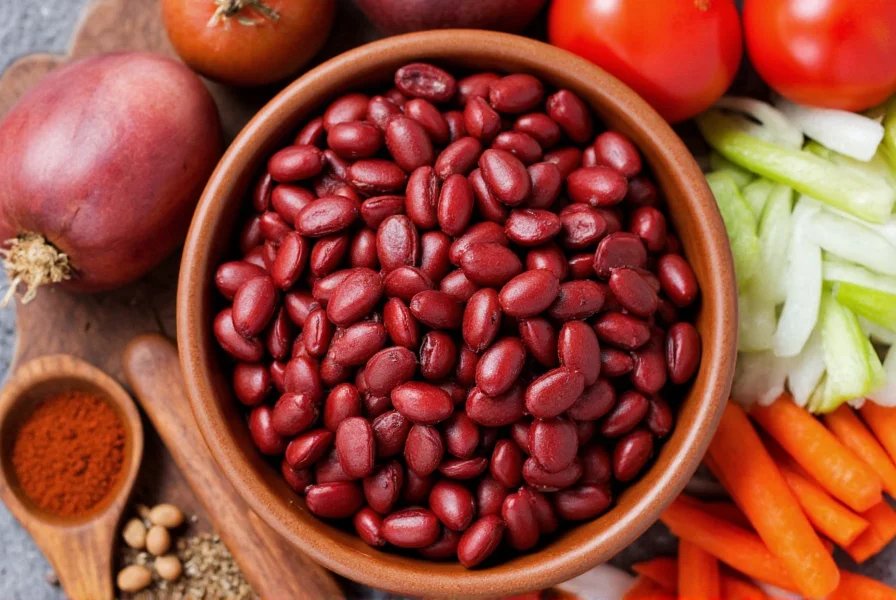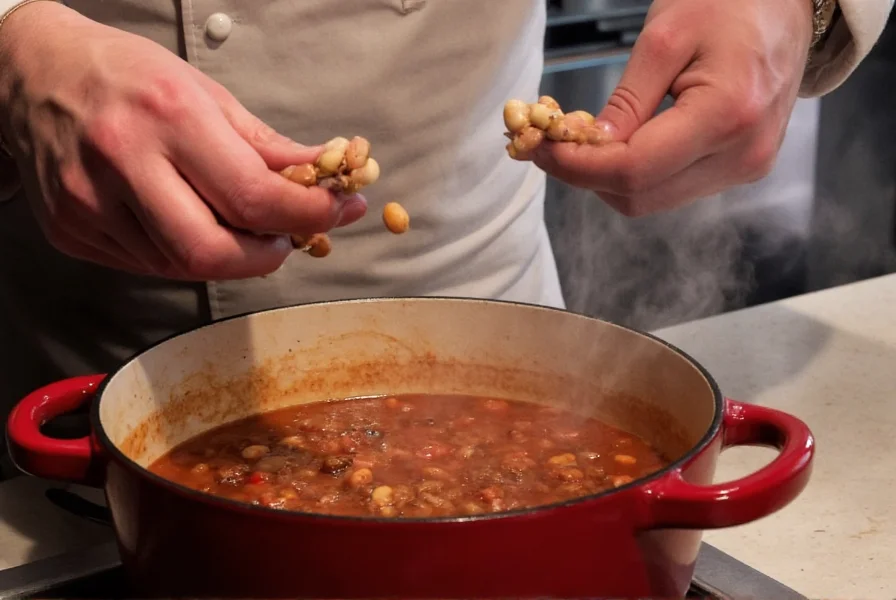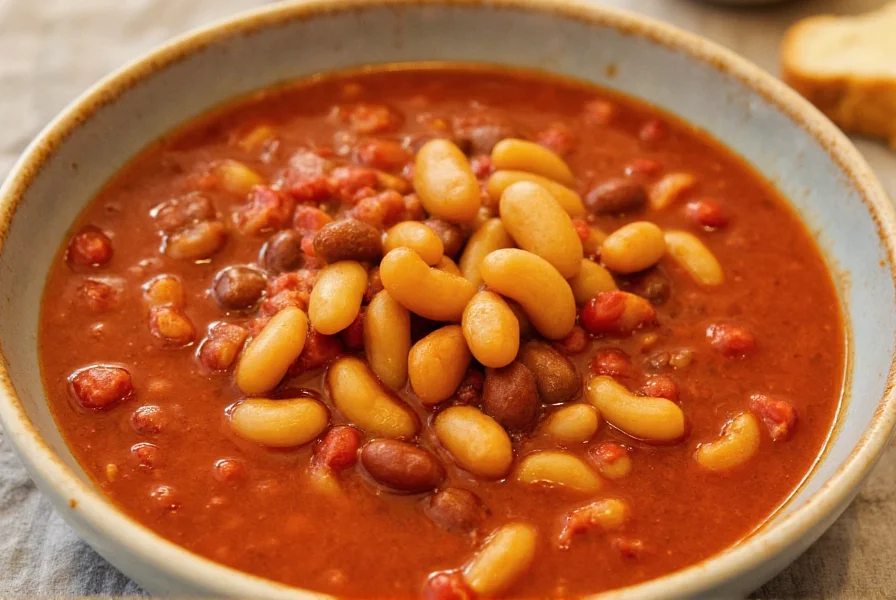Choosing the right beans can make or break your chili recipe. While some traditional Texas-style chili recipes omit beans entirely, most home cooks and regional variations incorporate beans for added texture, protein, and heartiness. Understanding which beans work best for your specific chili style transforms an ordinary pot into an exceptional meal.
The Science Behind Beans in Chili
Beans interact with chili's acidic tomatoes and spices in specific ways that affect both texture and flavor absorption. The starch content in beans helps thicken chili naturally, while their protein content provides nutritional balance. Different bean varieties have varying levels of:
- Cellulose structure (affects how well they hold shape)
- Starch content (impacts thickening ability)
- Flavor neutrality or distinctiveness
- Reaction to acidic ingredients
When selecting beans for chili, consider whether you want them to maintain distinct shape, break down to thicken the broth, or provide a specific flavor profile that complements your other ingredients.
Top Bean Varieties Compared
| Bean Type | Best For | Texture in Chili | Preparation Tip |
|---|---|---|---|
| Red Kidney Beans | Classic chili, Cincinnati-style | Firm, holds shape well | Add during last 30 minutes of cooking |
| Pinto Beans | Texas-style with beans, New Mexico chili | Creamy, partially breaks down | Soak overnight for even cooking |
| Black Beans | Southwestern, vegetarian chili | Firm with earthy flavor | Add acid (vinegar) to cooking water |
| Cannellini Beans | White chili, turkey chili | Delicate, creamy | Add very late in cooking process |
Why Kidney Beans Reign Supreme for Traditional Chili
Among all bean varieties, red kidney beans remain the most popular choice for chili con carne. Their dense structure withstands hours of simmering without disintegrating, providing satisfying texture contrast against the meat and broth. The mild flavor of kidney beans absorbs surrounding spices without overpowering them.
When using kidney beans for chili, proper preparation prevents common issues. Many home cooks experience mushy beans in chili because they add canned beans too early or fail to rinse them properly. For optimal results with canned kidney beans:
- Rinse thoroughly under cold water to remove excess sodium and canning liquid
- Add during the final 20-30 minutes of cooking
- Choose no-salt-added varieties to control sodium levels
For dried kidney beans, the best method to cook beans for chili involves an overnight soak followed by par-cooking before adding to the chili pot. This ensures even texture and eliminates potential digestive discomfort.

Pinto Beans: The Texas Chili Secret
While purists argue that true Texas chili contains no beans, many Texans actually incorporate pinto beans in their home recipes. Pinto beans offer a creamier texture that naturally thickens chili while providing a subtle earthy flavor that complements beef and spices.
The difference between kidney beans and pinto beans for chili comes down to texture preference. Pintos break down slightly during cooking, creating a thicker broth, while kidney beans maintain distinct shape. For the best results with pinto beans:
- Soak dried pinto beans for 8-12 hours before cooking
- Add a pinch of baking soda to soaking water to improve tenderness
- Cook separately until just tender before adding to chili
Many chili competitions actually feature pinto beans in their recipes, despite the "no beans" reputation of Texas chili. The key is proper preparation to avoid beans falling apart in chili.
Black Beans for Modern Chili Variations
Black beans have gained popularity in contemporary chili recipes, particularly for vegetarian and Southwestern-style versions. Their dense texture holds up well in spicy broths, and their earthy flavor complements ingredients like corn, cumin, and chipotle peppers.
When using black beans in chili, add them later in the cooking process than other beans since they maintain their shape exceptionally well. For best beans for white chicken chili, consider substituting black beans with cannellini or great northern beans, which provide similar texture with more neutral flavor.
Avoiding Common Bean Problems in Chili
Even experienced cooks encounter issues with beans in chili. Understanding these problems and their solutions ensures perfect results every time:
Mushy Beans
Cause: Overcooking, adding beans too early, or using canned beans without rinsing
Solution: Add canned beans during the final 20 minutes of cooking; for dried beans, par-cook separately to desired tenderness before adding to chili
Undercooked Beans
Cause: Insufficient soaking or cooking time, especially with dried beans
Solution: Soak dried beans overnight; cook separately until tender before adding to acidic chili mixture (acid prevents beans from softening)
Bland-Flavored Beans
Cause: Not seasoning bean cooking water or adding beans too late
Solution: Cook dried beans in seasoned broth; add canned beans with enough time to absorb flavors (20-30 minutes)

Canned vs. Dried Beans: Making the Right Choice
The debate between canned beans versus dried beans for chili comes down to convenience versus control. Canned beans offer immediate usability but come with added sodium and less texture control. Dried beans require planning but deliver superior flavor absorption and texture.
For competition-level chili, dried beans are almost always preferred. The extra preparation time allows for complete control over texture and flavor integration. When using dried beans:
- Sort and rinse before soaking
- Soak in cold water for 8-12 hours
- Cook in fresh water with aromatics (onion, garlic, bay leaf)
- Par-cook to just below desired tenderness before adding to chili
For weeknight cooking, low-sodium canned beans provide excellent results when properly rinsed and added at the right time in the cooking process.
Regional Bean Traditions in Chili
Bean selection often follows regional chili traditions. Understanding these patterns helps create authentic-tasting chili:
- Texas chili: Traditionally bean-free, but when included, pintos are preferred
- Cincinnati chili: Features kidney beans as a key ingredient
- New Mexico chili: Often includes pinto beans with red or green chili
- Colorado chili: Typically bean-free but sometimes includes pintos
- Vegetarian chili: Frequently combines multiple bean varieties
When recreating regional styles, matching the traditional bean selection enhances authenticity. For best beans for vegetarian chili recipes, consider combining black beans, kidney beans, and pinto beans for varied texture and complete protein.
Perfecting Your Bean Integration Technique
The timing of bean addition significantly impacts final texture. Follow these guidelines for how to add beans to chili properly:
- For canned beans: Add during the final 20-30 minutes of cooking
- For pre-cooked dried beans: Add during the final 15-20 minutes
- For uncooked dried beans: Soak overnight, then cook separately until tender before adding
- Never add dried beans directly to acidic chili mixtures (tomatoes prevent softening)
For the best texture beans in chili, consider partially mashing some beans before adding to thicken the broth naturally while maintaining whole bean texture throughout.
Frequently Asked Questions
What are the best beans for traditional beef chili?
Red kidney beans are considered the best for traditional beef chili because they maintain their shape during long cooking times while absorbing flavors well. Pinto beans are also popular in many regional variations for their creamy texture that helps thicken the chili.
Should I use canned or dried beans for chili?
Canned beans offer convenience and are suitable for weeknight cooking when rinsed well and added late in the cooking process. Dried beans require soaking and pre-cooking but deliver superior texture control and flavor absorption, making them preferable for special occasions or competition chili.
Why do my beans turn mushy in chili?
Beans become mushy in chili when added too early in the cooking process or when canned beans aren't rinsed properly. Acidic ingredients like tomatoes prevent beans from softening, so adding beans late (during the final 20-30 minutes) preserves their texture. Properly rinsing canned beans removes excess starch that contributes to mushiness.
Can I use black beans in traditional chili recipes?
While not traditional in classic beef chili recipes, black beans work well in Southwestern-style, vegetarian, or turkey chili. Their earthy flavor and firm texture hold up well in spicy broths. For traditional chili, kidney or pinto beans remain the standard choices that most closely match regional expectations.
How do I prevent gas from beans in chili?
To reduce digestive issues from beans in chili, always rinse canned beans thoroughly, or for dried beans, change the soaking water once and discard it before cooking. Adding kombu seaweed during cooking or including epazote herb in Mexican-style chili can also help improve digestibility.











 浙公网安备
33010002000092号
浙公网安备
33010002000092号 浙B2-20120091-4
浙B2-20120091-4